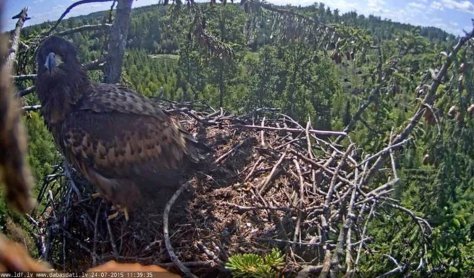VIDEO and about a young bird’s plumage
Video recorded by Ame, LK forum
Translation Liis
White-tailed eagle Merikotkas Haliaeëtus albicilla
The shrill calls of the young WTE can be heard every day in the nest surroundings – but it is rarely seen, maybe once a day.
There has been great progress in flying, landing on the nest already proceeds smoothly as for an ”old hand”. The weather has been windy, for Sunday a summer gale is predicted with winds of 20 m/s, in gusts even more.
Let us have a look at the plumage of our young bird; it is quite fresh for him. The head and neck plumage of a young bird is dark brown. The breast, underbelly, back and upper side of the wings are somewhat lighter brown (reddish in some individuals, but there are also juveniles with darker or lighter plumages), and the tips of the feathers are black. The wings have dark undersides.
Compared to adults the secondaries of the wings of juveniles are longer (these begin roughly in the centre of the wing) and so the wings seem broader in the centre or a little more rounded. The tail feathers are longer compared to those of adults and the tail is not wedge-shaped and looks dark (in a good light and when the tail is spread out a few slightly lighter feathers are already visible). The beak of a juvenile is dark, but the light cere, or wax patch, is visible from far off.
Around the turn of the year a new plumage will begin to replace the already sufficiently worn and used one. This will still be changed during a few years and each time into something different-looking from the previous, until we can see the young grown up white-tailed eagle in the plumage that has become familiar to us.
Today’s image captured from the webcam by Liz, LK forum









